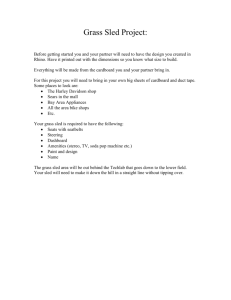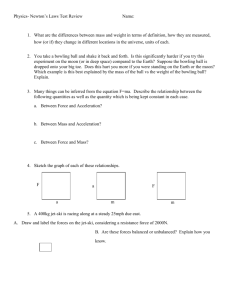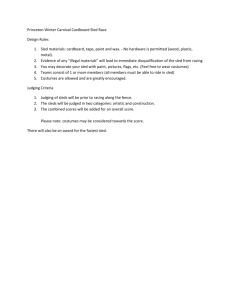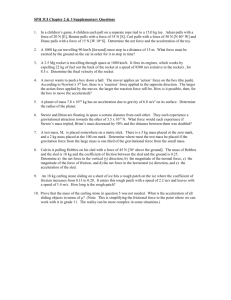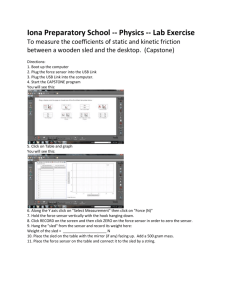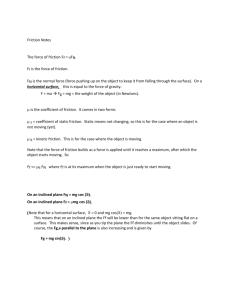Static and Kinetic Coefficients of Friction of Plastic Film and Sheeting1
advertisement
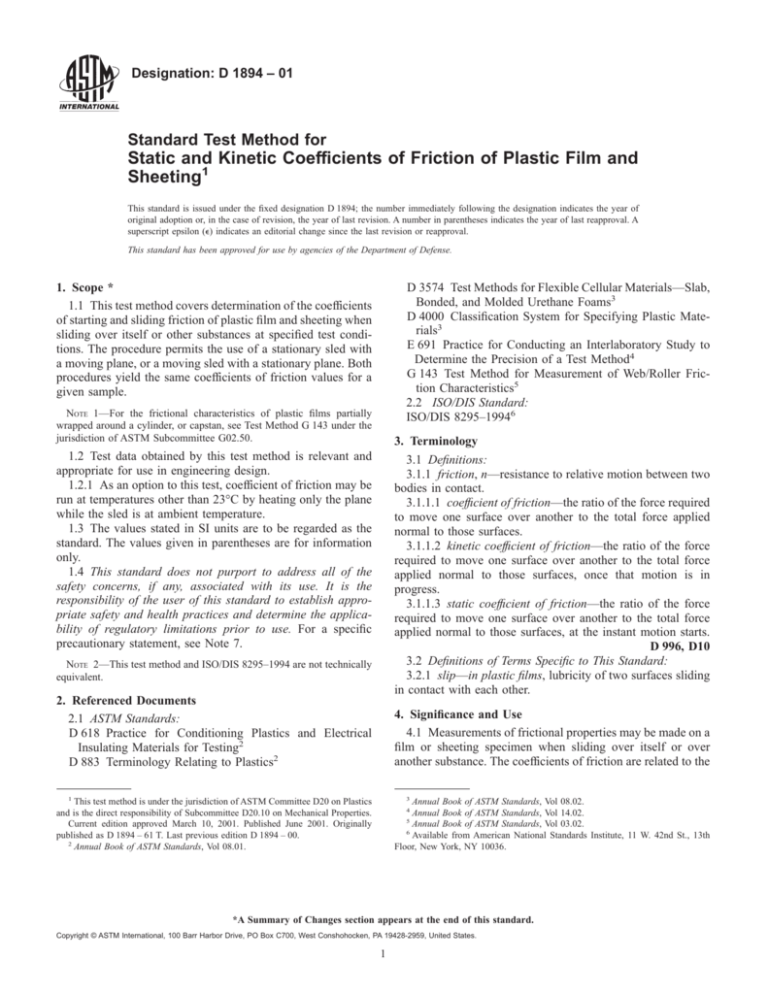
Designation: D 1894 – 01 Standard Test Method for Static and Kinetic Coefficients of Friction of Plastic Film and Sheeting1 This standard is issued under the fixed designation D 1894; the number immediately following the designation indicates the year of original adoption or, in the case of revision, the year of last revision. A number in parentheses indicates the year of last reapproval. A superscript epsilon (e) indicates an editorial change since the last revision or reapproval. This standard has been approved for use by agencies of the Department of Defense. 1. Scope * 1.1 This test method covers determination of the coefficients of starting and sliding friction of plastic film and sheeting when sliding over itself or other substances at specified test conditions. The procedure permits the use of a stationary sled with a moving plane, or a moving sled with a stationary plane. Both procedures yield the same coefficients of friction values for a given sample. D 3574 Test Methods for Flexible Cellular Materials—Slab, Bonded, and Molded Urethane Foams3 D 4000 Classification System for Specifying Plastic Materials3 E 691 Practice for Conducting an Interlaboratory Study to Determine the Precision of a Test Method4 G 143 Test Method for Measurement of Web/Roller Friction Characteristics5 2.2 ISO/DIS Standard: ISO/DIS 8295–19946 NOTE 1—For the frictional characteristics of plastic films partially wrapped around a cylinder, or capstan, see Test Method G 143 under the jurisdiction of ASTM Subcommittee G02.50. 3. Terminology 3.1 Definitions: 3.1.1 friction, n—resistance to relative motion between two bodies in contact. 3.1.1.1 coeffıcient of friction—the ratio of the force required to move one surface over another to the total force applied normal to those surfaces. 3.1.1.2 kinetic coeffıcient of friction—the ratio of the force required to move one surface over another to the total force applied normal to those surfaces, once that motion is in progress. 3.1.1.3 static coeffıcient of friction—the ratio of the force required to move one surface over another to the total force applied normal to those surfaces, at the instant motion starts. D 996, D10 3.2 Definitions of Terms Specific to This Standard: 3.2.1 slip—in plastic films, lubricity of two surfaces sliding in contact with each other. 1.2 Test data obtained by this test method is relevant and appropriate for use in engineering design. 1.2.1 As an option to this test, coefficient of friction may be run at temperatures other than 23°C by heating only the plane while the sled is at ambient temperature. 1.3 The values stated in SI units are to be regarded as the standard. The values given in parentheses are for information only. 1.4 This standard does not purport to address all of the safety concerns, if any, associated with its use. It is the responsibility of the user of this standard to establish appropriate safety and health practices and determine the applicability of regulatory limitations prior to use. For a specific precautionary statement, see Note 7. NOTE 2—This test method and ISO/DIS 8295–1994 are not technically equivalent. 2. Referenced Documents 2.1 ASTM Standards: D 618 Practice for Conditioning Plastics and Electrical Insulating Materials for Testing2 D 883 Terminology Relating to Plastics2 4. Significance and Use 4.1 Measurements of frictional properties may be made on a film or sheeting specimen when sliding over itself or over another substance. The coefficients of friction are related to the 1 This test method is under the jurisdiction of ASTM Committee D20 on Plastics and is the direct responsibility of Subcommittee D20.10 on Mechanical Properties. Current edition approved March 10, 2001. Published June 2001. Originally published as D 1894 – 61 T. Last previous edition D 1894 – 00. 2 Annual Book of ASTM Standards, Vol 08.01. 3 Annual Book of ASTM Standards, Vol 08.02. Annual Book of ASTM Standards, Vol 14.02. 5 Annual Book of ASTM Standards, Vol 03.02. 6 Available from American National Standards Institute, 11 W. 42nd St., 13th Floor, New York, NY 10036. 4 *A Summary of Changes section appears at the end of this standard. Copyright © ASTM International, 100 Barr Harbor Drive, PO Box C700, West Conshohocken, PA 19428-2959, United States. 1 D 1894 The foam shall also have a high hysteresis when deformed.7 The rubber shall be wrapped snugly around the sled and held in place against the bottom and top of the sled with doublefaced masking tape. When a sheet (see 6.3) is to be attached, double-faced tape shall be used to attach the specimen. The total weight of the (wrapped) sled and specimen shall be 200 6 5 g. slip properties of plastic films that are of wide interest in packaging applications. These methods yield empirical data for control purposes in film production. Correlation of test results with actual performance can usually be established. 4.1.1 This test method includes testing at temperatures other than 23°C by heating only the plane while the sled is at ambient temperature. 4.2 Slip properties are generated by additives in some plastic films, for example, polyethylene. These additives have varying degrees of compatibility with the film matrix. Some of them bloom, or exude to the surface, lubricating it and making it more slippery. Because this blooming action may not always be uniform on all areas of the film surface, values from these tests may be limited in reproducibility. 4.3 The frictional properties of plastic film and sheeting may be dependent on the uniformity of the rate of motion between the two surfaces. Care should be exercised to ensure that the rate of motion of the equipment is as carefully controlled as possible. 4.4 Data obtained by these procedures may be extremely sensitive to the age of the film or sheet and the condition of the surfaces. The blooming action of many slip additives is time-dependent. For this reason, it is sometimes meaningless to compare slip and friction properties of films or sheets produced at different times, unless it is desired to study this effect. 4.5 Frictional and slip properties of plastic film and sheeting are based on measurements of surface phenomena. Where products have been made by different processes, or even on different machines by the same process, their surfaces may be dependent on the equipment or its running conditions. Such factors must be weighed in evaluating data from these methods. 4.6 The measurement of the static coefficient of friction is highly dependent on the rate of loading and on the amount of blocking occurring between the loaded sled and the platform due to variation in time before motion is initiated. 4.7 Care should be exercised to make certain that the speed of response of the recorder, either electronic or mechanical, is not exceeded. 4.8 For many materials, there may be a specification that requires the use of this test method, but with some procedural modifications that take precedence when adhering to the specification. Therefore, it is advisable to refer to that material specification before using this test method. Table 1 of Classification System D 4000 lists the ASTM materials standards that currently exist. NOTE 3—Round-robin testing8 has shown that the physical properties of the backing can drastically affect both the coefficient of friction and stick-slip behavior of the film. 5.2 Plane—A polished plastic, wood, or metal sheet,9 approximately 150 by 300 by 1 mm (6 by 12 by 0.040 in.). A smooth, flat piece of glass may cover the upper surface of the plane. This provides a smooth support for the specimen. 5.2.1 When it is desirable to run tests at temperatures above 23°C, a heating unit shall be provided that is capable of maintaining the temperature of the plane within 62°C of the desired temperature. The temperature should be maintained within 62°C of the desired temperature over the entire traverse of the sled (that is, over the full surface of the plane). NOTE 4—If the equipment has a plane with a heater, a cover may be used to help maintain the temperature of the plane within 62°C of the desired temperature. 5.3 Scissors or Cutter, suitable for cutting specimens to the desired dimensions. 5.4 Adhesive Tape, cellophane or pressure-sensitive. 5.5 Adhesive Tape, double-faced. 5.6 Nylon Monofilament, having a 0.33 6 0.05-mm (0.013 6 0.002-in.) diameter and capable of supporting a 3.6-kg (8-lb) load. 5.7 Beaded Chain, flexible metal cable, or equivalent, having a spring rate no less than 600 lbs per inch of stretch per inch of length (40 lbs/in. (7000 N/m) for a 15-in. chain) in the range of 50 to 150 g of tension (such as beaded lampswitch pull chain). 5.8 Low-Friction Pulleys—A phenolic type pulley mounted in hardened steel cone bearings on a metal fork. A ball-bearing type pulley may also be used. 5.9 Force-Measuring Device, capable of measuring the frictional force to 65 % of its value. A spring gage10 (Note 3), universal testing machine, or strain gage may be used. NOTE 5—The capacity of the spring gage (Fig. 1( a and b)) needed will depend upon the range of values to be measured. For most plastic, a 500-g capacity gage with 10-g or smaller subdivisions will be satisfactory. This spring will measure coefficients of friction up to and including 2.5. 5.10 Supporting Base—A smooth wood or metal base approximately 200 by 380 mm (8 by 15 in.) is necessary to support the plane. The supporting base may be a simple rectangular box. If a universal testing machine is used to pull 5. Apparatus 5.1 Sled—A metal block 63.5 mm (21⁄2 in.) square by approximately 6 mm (0.25 in.) thick with a suitable eye screw fastened in one end. When a flexible film (see 6.2) is to be attached, the block shall be wrapped with a sponge rubber 63.5 mm (2 1⁄2in.) in width and 3.2 mm (1⁄8in.) in thickness. The foam shall be flexible, smooth-faced, and have a nominal density of 0.25 g/cm3 when measured in accordance with the Density Test of Methods D 3574. The pressure required to compress the foam 25 % shall be 85 6 15 kPa (12.5 6 2.5 psi). 7 Sheet stock, available from Greene Rubber Co., 59 Broadway, North Haven, CT 06473, has been found satisfactory. 8 Supporting data are available from ASTM Headquarters. Request RR: D201065. 9 Acrylic or rigid poly(vinyl chloride) sheeting has been found satisfactory for this purpose. 10 Model L-500, available from Hunter Spring Co., Lansdale, PA, has been found satisfactory for this purpose. 2 D 1894 A. Sled B. Plane C. Supporting base D. Gage E. Spring gage F. Constant-speed chain drive G. Constant-speed tensile tester crosshead H. Constant-speed drive rolls I. Nylon monofilament J. Low-friction pulley K. Worm screw L. Half nut M. Hysteresis, synchronous motor FIG. 1 Five Methods of Assembly of Apparatus for Determination of Coefficients of Friction of Plastic Film a moving plane, a supporting base of sufficient structural strength and rigidity to maintain a firm position between the moving crosshead and the force-measuring device will be necessary. 5.11 Driving or Pulling Device for Sled or Plane—The plane may be pulled by a driven pair of rubber-coated rolls not less than 200 mm (8 in.) long, capable of maintaining a uniform surface speed 150 6 30 mm/min (0.5 6 0.1 ft/min) (Fig. 1(b)), by the crosshead of a universal testing machine (Fig. 1(d)) (Note 7), or a worm drive driven with a synchronous motor (Fig. 1(e)). A constant-speed chain drive system has also been found satisfactory (Fig. 1(a)). A power-operated source may be used for pulling the sled over the horizontally-mounted specimen at a uniform speed of 150 6 30 mm/min (0.5 6 0.1 ft/min). A universal testing machine equipped with a load cell in its upper crosshead and a constant rate-of-motion lower crosshead has been found satisfactory (see Fig. 1(c)). used to pull the moving plane through a pulley system (Fig. 1(d)), the strain gage load cell, or other load-sensing instrument in the testing machine, acts as the force-measuring device. 6. Test Specimens 6.1 The test specimen that is to be attached to the plane shall be cut approximately 250 mm (10 in.) in the machine direction and 130 mm (5 in.) in the transverse direction when such extrusion directions exist and are identifiable. 6.2 A film specimen that is to be attached to the sled shall be cut approximately 120 mm (41⁄2in.) square. Film is defined as sheeting having a nominal thickness of not greater than 0.254 mm as indicated in Terminology D 883. 6.3 A sheeting specimen (greater than 0.254 mm nominal thickness) or another substance that is to be attached to the sled shall be cut 63.5 mm (21⁄2 in.) square. 6.4 Sheeting specimens shall be flat and free of warpage. Edges of specimens shall be rounded smooth. NOTE 6—Where the moving crosshead of a universal testing machine is 3 D 1894 conditioning requirements cannot be met and the data still may be of direct assistance to the operation, other conditioning procedures may be used and recorded in the report. Frictional properties should be measured only after sufficient time has been allowed for the specimens to reach essential equilibrium with the ambient atmosphere. 6.5 Five specimens shall be tested for each sample unless otherwise specified. NOTE 7—Plastic films and sheeting may exhibit different frictional properties in their respective principal directions due to anisotropy or extrusion effects. Specimens may be tested with their long dimension in either the machine or transverse direction of the sample, but it is more common practice to test the specimen as described in 6.1 with its long dimension parallel to the machine direction. NOTE 8—Caution: Extreme care must be taken in handling the specimens. The test surface must be kept free of all dust, lint, finger prints, or any foreign matter that might change the surface characteristics of the specimens. 9. Procedure 9.1 Tape the 250 by 130-mm (10 by 5-in.) film or sheet specimen to the plane with the machine direction of the specimen in the 250-mm direction. Smooth the film specimen to eliminate wrinkles if necessary, taking care not to alter the specimen surface through finger oils, etc. 7. Preparation of Apparatus 7.1 Fig. 1 shows five ways in which the apparatus may be assembled. The support bases for all apparatus assemblies shall be level. 7.2 If the apparatus of Fig. 1(a) or (b) is used, calibrate the scale of the spring gage as follows: 7.2.1 Mount the low-friction pulley in front of the spring gage. 7.2.2 Fasten one end of the nylon filament to the spring gage, bring the filament over the pulley, and suspend a known weight on the lower end of the filament to act downward. NOTE 10—For some samples it has been found necessary to tape only the leading edge of the specimen to the plane. In some cases the specimen has been pulled through the nip rolls apparatus of Fig. 1(b) without the plane. However, should any dispute arise, taping of all four edges will be the referee method. NOTE 11—For the sake of uniformity and later comparison when testing a specimen sliding over itself, the specimens shall be mounted so that the same side of the specimen shall be used as the contact surface for both the moving and stationary specimens. NOTE 12—Coefficient of friction measurements may be made on a film or sheeting specimen when sliding over itself or over other substance surfaces wherein the movement is made in the transverse direction of the specimen. However, the methods described here will be confined to movements in the machine direction of the specimens. NOTE 9—The reading on the scale shall correspond to the known weight within6 5 %. The weight used for this calibration shall be between 50 and 75 % of the scale range on the gage. 9.2 For film specimens, tape the edges of the 120-mm (41⁄2-in.) square film specimen to the back of the sled, using adhesive tape and pulling the specimen tight to eliminate wrinkles without stretching it. For sheet specimens, tape the 63.5-mm (21⁄2-in.) square sheet specimen or second substrate to the sled face with double faced tape. Keep the machine direction of the specimen parallel to the length of the sled (where such a direction exists and is identifiable). 9.3 Attach the specimen-covered sled through its eye screw to the nylon filament. If a universal testing machine is used (Fig. 1(c and d)), pass the filament through pulley(s) and upward to the bottom of the load-sensing device and attach securely. If a spring gage is used (Fig. 1(a and b)), securely attach the filament to it. The nylon filament shall be of sufficient length to allow maximum sled or plane travel. With some slack in the nylon filament, lightly place the sled in position on the horizontal plane (Note 12). The positioning of the sled shall be such that the length of the sled, the adjacent length of nylon filament, and the long dimension (machine direction) of the plane-mounted specimen are parallel. For material combinations found to have an excessive stick-slip tendency, wherein the kinetic portion of the test degenerates into a series of static tests interspersed by rapid jumps of the sled, it is advisable but not mandatory to substitute the metal tow line (5.7) for the nylon tow line to make kinetic measurements. This will necessitate making separate measurements for static and kinetic friction coefficients. Each laboratory will determine what level of stick-slip is considered excessive for its materials. In case of disagreement between testing laboratories, the nylon tow line remains the referee procedure. 7.3 The drive speed for the apparatus of Fig. 1(a and b) shall be adjusted to 150 6 30 mm/min (6.0 6 1.2 in./min). This speed may be checked by marking off a 150-mm (6.0 in.) section beside the plane and determining the time required for the plane to travel 150 mm. 7.4 If the apparatus of Fig. 1(c and d) employing a universal testing machine is used, select the proper speed setting for a crosshead motion of 150 6 30 mm/min (6.0 6 1.2 in./min). A similar speed for the load-displacement recorder is desirable. However, the speed of the recorder can be adjusted to give the desired accuracy in reading the pen trace. 7.5 When the apparatus of Fig. 1(c) (moving sled-stationary plane) is used, wipe the support base free of foreign matter and lay down two strips of double-faced adhesive tape along the length of the supporting base so that they are approximately 100 mm (4 in.) between centers. 7.6 Fix the plane in position on the tape strips and firmly press in place. 8. Conditioning 8.1 Conditioning—Condition the test specimens at 23 6 2°C (73.4 6 3.6°F) and 50 6 5 % relative humidity for not less than 40 h prior to test in accordance with Procedure A of Practice D 618, for those tests where conditioning is required. In cases of disagreement, the tolerances shall be6 1°C (61.8°F) and 62 % relative humidity. 8.2 Test Conditions—Conduct tests in the standard laboratory atmosphere of 23 6 2°C (73.4 6 3.6°F) and 50 6 5 % relative humidity, unless otherwise specified in the test methods or in this test method. In cases of disagreement, the tolerances shall be 61°C (61.8°F) and 62 % relative humidity. In specific cases, such as control testing, where the NOTE 13—The purpose of using a nylon filament for the static friction and sometimes a metallic tow line for kinetic friction is to avoid a faster 4 D 1894 force buildup in the static measurement than the recorder can respond to, and to allow time for the recorder to separate the buildup of static friction force in the nylon filament from the mass acceleration force as the sled breaks loose. The opposite effect is needed from the metallic tow line during kinetic friction measurement to prevent the occurrence of repeated stick-slips instead of steady motion. NOTE 14—The sled must be placed very lightly and gently on the plane to prevent any unnatural bond from developing. A high starting coefficient of friction may be caused by undue pressure on the sled when mounting it onto the plane. Ak = average scale reading obtained during uniform sliding of the film surfaces, g, and B = sled weight, g. 10.3 Calculate the arithmetic mean of each set of observations and report these values to three significant figures. 10.4 Calculate the standard deviation (estimated to be6 15 % of the value of the coefficient of friction) as follows, and report it to two significant figures: s 5 =~ (X 2 2 n X̄ 2!/~n 2 1! 9.4 Start the driving mechanism (which has been adjusted previously to provide a speed of 150 6 30 mm/min (6.0 6 1.2 in./min)). As a result of the frictional force between the contacting surfaces, no immediate relative motion may take place between the sled and the moving plane until the pull on the sled is equal to, or exceeds, the static frictional force acting at the contact surfaces. Record this initial, maximum reading as the force component of the static coefficient of friction. 9.4.1 If conducting the test at temperatures above 23°C (the temperature of the plane), ensure that sufficient time for the interface to reach the temperature of the plane has elapsed before starting the driving mechanism. 9.5 Record the visual average reading during a run of approximately 130 mm (5 in.) while the surfaces are sliding uniformly over one another. This is equivalent to the kinetic force required to sustain motion between the surfaces and normally is lower than the static force required to initiate motion. After the sled has traveled over 130 mm (5 in.) stop the apparatus and return to the starting position. 9.6 If a strain gage and load-displacement recorder are used, either draw the best straight line midway between the maximum points and minimum points shown on the chart while the sled is in motion, or obtain the average load by integration of the recorder trace. The mean load is the kinetic friction force required to sustain motion on the sled. 9.7 Remove the film or sheeting specimen from the sled and the horizontal plane. The apparatus is now ready for the next set of specimens. A new set of specimens shall be used for each run. No specimen surface(s) shall be tested more than once unless such tests constitute one of the variables to be studied. where: s = sample standard deviation, X = value of a single observation, n = number of observations, and X = arithmetic mean of the set of observations. 11. Report 11.1 Report the following information: 11.1.1 Complete description of the plastic sample, including manufacturer’s code designation, thickness, method of production, surfaces tested, principal directions tested, and approximate age of sample after manufacture, 11.1.2 Description of second substance if used, 11.1.3 Apparatus used, 11.1.4 Average static and kinetic coefficients of friction, together with the standard deviation, 11.1.5 Number of specimens tested for each coefficient of friction, and 11.1.6 The temperature of the plane at which the test was conducted. 12. Precision and Bias 11 12.1 Precision—Table 1 is based on a round robin con- 11 Supporting data are available from ASTM Headquarters. Request RR: D20- 1131. TABLE 1 Precision Data at 23°C Material NOTE 15—The maximum point at which initial motion takes place between the sled and the horizontal plane should be carefully examined with reference to the rate of loading and the speed of response of the sensing device. Failure to consider this factor can lead to meaningless results for the value of the static coefficient of friction. Polyethylene, (M3) Polyethylene, (M4) Polyester, (M1) Polyester, (M2) 10. Calculation 10.1 Calculate the static coefficient of friction µs, as follows: µs 5 As/B Material (1) Polyethylene, (M3) Polyethylene, (M4) Polyester, (M1) Polyester, (M2) where: As = initial motion scale reading, g, and B = sled weight, g. 10.2 Calculate the kinetic coefficient of friction, µk, as follows: µk 5 Ak/B (3) A Static Coefficient of Friction at 23°C Avg SrA SRB IrC IRD 0.18 0.018 0.066 0.050 0.186 0.19 0.027 0.135 0.077 0.383 0.20 0.009 0.037 0.025 0.104 0.70 0.066 0.094 0.186 0.265 Kinetic Coefficient of Friction at 23°C Avg SrA SRB IrC 0.19 0.007 0.046 0.019 0.131 0.12 0.007 0.025 0.021 0.071 0.17 0.005 0.021 0.015 0.059 0.66 0.054 0.123 0.154 0.349 Sr = within-laboratory standard deviation of the average, SR = between-laboratories standard deviation of the average, C Ir = 2.83 Sr, and D IR = 2.83 SR. (2) B where: 5 IRD D 1894 material tested by one laboratory. The average is based upon 18 specimens tested by one operator using one instrument in accordance with this test method. 12.3 Concept of Ir and IR—If Sr and SR were calculated from a large enough body of data, and for test results that were averages from the number of determinations stated in 12.1. 12.3.1 Repeatability, Ir (Comparing two test results for the same material, obtained by the same operator using the same equipment on the same day)—The samples represented by the two results should be regarded as not having equivalent friction if they differ by more than the Ir value for that material and condition. 12.3.2 Reproducibility, IR (Comparing two test results for the same material, obtained by different operators using different equipment on different days)—The samples represented by the two test results should be regarded as not having equivalent friction if they differ by more than the IR value for that material and condition. 12.3.3 Any judgment in accordance with 12.3.1 and 12.3.2 would have an approximate 95 % (0.95) probability of being correct. 12.4 Bias—There are no recognized standards on which to base an estimate of bias for this test method. ducted in 1986 in accordance with Practice E 691, involving four materials tested by seven laboratories. For each material, all of the samples were prepared at one source. Each laboratory obtained seven test results for each material. Each test result was one determination per each material. Sr and SR are based on five determinations for five materials in accordance with the test method. The temperature of the plane was 23°C for all of the tests. NOTE 16—Caution: The following explanations of Ir and IR (12.312.3.3 ) are only intended to present a meaningful way of considering the approximate precision of this test method. The data in Table 1 should not be rigorously applied to acceptance or rejection of material, as those data are specific to the round robin and may not be representative of other lots, conditions, materials, or laboratories. Users of this test method should apply the principles outlined in Practice E 691 to generate data specific to their laboratory and materials, or between specific laboratories. The principles of 12.3-12.3.3 would then be valid for such data. 12.2 Table 2 presents repeatability data at 38°C for one TABLE 2 Repeatability Data at 38°C Material Polyethylene Material Polyethylene A B Static Coefficient of Friction at 38°C Average SrA 0.330 0.023 Kinetic Coefficient of Friction at 38°C Average SrA 0.246 0.014 IrB 0.064 IrB 13. Keywords 0.041 13.1 friction; kinetic coefficient of friction; plastic film; plastic sheeting; slip; static coefficient of friction Sr = within-laboratory standard deviation of the average. Ir = 2.83 Sr. SUMMARY OF CHANGES This section identifies the location of selected changes to this test method. For the convenience of the user, Committee D20 has highlighted those changes that may impact the use of this test method. This section may also include descriptions of the changes or reasons for the changes, or both. D 1894–01: (1) Revised 1.2, 4.1, 5.2, and 9.4 to include testing at temperatures above 23°C. (2) Added Table 2. D 1894–99: (1) Added Note 2. D 1894–00: (1) Revised Section 3, Terminology. ASTM International takes no position respecting the validity of any patent rights asserted in connection with any item mentioned in this standard. Users of this standard are expressly advised that determination of the validity of any such patent rights, and the risk of infringement of such rights, are entirely their own responsibility. This standard is subject to revision at any time by the responsible technical committee and must be reviewed every five years and if not revised, either reapproved or withdrawn. Your comments are invited either for revision of this standard or for additional standards and should be addressed to ASTM International Headquarters. Your comments will receive careful consideration at a meeting of the responsible technical committee, which you may attend. If you feel that your comments have not received a fair hearing you should make your views known to the ASTM Committee on Standards, at the address shown below. This standard is copyrighted by ASTM International, 100 Barr Harbor Drive, PO Box C700, West Conshohocken, PA 19428-2959, United States. Individual reprints (single or multiple copies) of this standard may be obtained by contacting ASTM at the above address or at 610-832-9585 (phone), 610-832-9555 (fax), or service@astm.org (e-mail); or through the ASTM website (www.astm.org). 6
